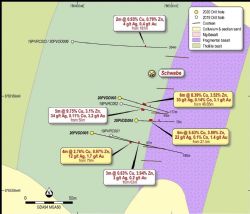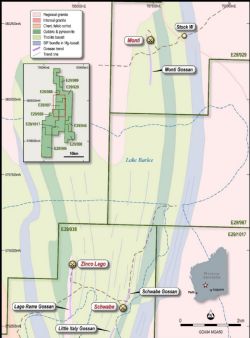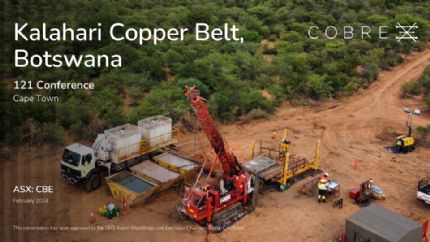 Significant High-Grade Copper Gold Results at Perrinvale
Significant High-Grade Copper Gold Results at Perrinvale
Sydney, April 16, 2020 AEST (ABN Newswire) - Cobre Limited ( ASX:CBE) is pleased to announce the assay results from the recent diamond drilling program at the Schwabe, Zinco Lago and Monti prospects within the Perrinvale Volcanic-Hosted Massive Sulphide (VHMS) Project located in Western Australia (refer Figure 5*).
ASX:CBE) is pleased to announce the assay results from the recent diamond drilling program at the Schwabe, Zinco Lago and Monti prospects within the Perrinvale Volcanic-Hosted Massive Sulphide (VHMS) Project located in Western Australia (refer Figure 5*).
Schwabe Prospect
As part of the program, four diamond core drill holes were completed at the Schwabe Prospect as shown in Figure 3*, including a tail on a Reverse Circulation (RC) hole drilled during the Company's initial exploration program in 2019. These drill holes are named 20PVDD003, 20PVDD004, 20PVDD005 and 20PVDD006 (tail). Detailed logging of the Schwabe core samples confirmed a VHMS system exists close to surface in this location.
The mineralised core intercepts at Schwabe comprise:
- DD Hole 20PVDD003 - 6m @ 8.39% Cu, 3.52% Zn, 30g/t Ag, 0.14% Co, 3.1g/t Au from 49m.
- DD Hole 20PVDD004 - 6m @ 5.63% Cu, 3.89% Zn, 22g/t Ag, 0.1% Co, 1.4g/t Au from 28m.
- DD Hole 20PVDD005 - 4m @ 2.76% Cu, 0.97% Zn, 12g/t Ag, 1.7g/t Au from 79m.
A full profile of primary massive sulphide mineralisation from the footwall sediments up to the top of the pile (48.65m down hole) where a botryoidal fabric, likely to represent either colloform growth from sulphide precipitation in seafloor muds or fragments of collapsed hydrothermal chimneys, is present in hole 20PVDD003 (refer Figure 1*).
Following the core drilling, Down Hole Electromagnetic (DHEM) surveys were conducted at the Schwabe Prospect. These DHEM results align with the model constructed following the Airborne Electromagnetic (AEM) survey in 2019. Together, this analysis indicates the presence of a robust and highly conductive central zone within the existing Schwabe drill area, with potential for a lower conductivity zone extending to the north or north-northwest of the existing exploration area.
Zinco Lago Prospect
Two diamond core drill holes were completed at the Zinco Lago Prospect, named 20PVDD001 and 20PVDD002, as shown in Figure 6*. Both drill holes intersected lower-level base and precious metals mineralisation as follows:
- DD Hole 20PVDD001 - 10.2m @ 0.10% Cu, 0.63% Zn, 0.11g/t Au, 3.6g/t Ag from 31m (including: 0.8m @ 0.99% Cu, 1.42% Zn, 1.74 g/t Au, 20.04g/t Ag from 39m).
- DD Hole 20PVDD002 - 6.5m @ 0.33% Cu, 0.57% Zn, 0.02g/t Au, 3.9g/t Ag from 46m.
Both drill holes were collared in the hanging wall basalt, which sits above the primary mineralised horizon associated with a mixed mudstone, black shale and chert sedimentary sequence. Toward the base of this sequence, pockets of basaltic peperite are present. A footwall shear separates the mineralised horizon from a gabbroic intrusive. Locally, graphite is developed on sheared surfaces.
Measurements from the core combined with historic drill hole logs indicate the stratigraphy is dipping steeply to the east. Primary sulphides within the sedimentary sequence include pyrite, pyrrhotite and chalcopyrite as locally disseminated, veinlet and narrow (10-30cm) massive zones. Assays support some likely remobilisation of zinc into the hanging wall above the pockets of massive sulphides in the sediments, which are associated with locally elevated base metals and gold (refer Figures 6, 7 & 8*).
DHEM surveying was undertaken at both Zinco Lago locations, with a strong conductor identified below the drill holes. This conductor is not obvious in the AEM data. The spatial position of the modelled conductor is aligned with the down dip projection of the mineralised horizon identified in the drill core.
Monti Prospect
Three diamond core drill holes were completed at the Monti Prospect, named 20MTDD001, 20MTDD002 and 20MTDD003, as shown in Figure 9*. The holes targeted areas of copper-bearing surface gossan and intersected generally low levels of primary sulphides including disseminated, veinlet and blebby/clustered pyrrhotite, pyrite, chalcopyrite and sphalerite. Some broad base metal mineralisation was intersected as follows:
- DD Hole 20MTDD002 - 26m @ 0.32% Cu, 0.08% Zn, 0.10g/t Au, 3.07g/t Ag from 105m.
- DD Hole 20MTDD003 - 11m @ 0.08% Cu, 0.23% Zn, 0.04g/t Au, 1.07g/t Ag from 64m.
In the north, drill holes 20MTDD001 and 20MTDD002 showed an altered ultramafic on the east side, a variably sheared zone including locally autoclastic/hyaloclastic basalt and deformed sediments, with a massive basalt on the west side. Local zones of low level pyrrhotite, pyrite, chalcopyrite, and sphalerite are present. The drill hole cross section (refer Figure 10*) shows minor mineralisation in 20MTDD001 above the 20MTDD002 trace.
Drill hole 20MTDD003, collared approximately 700m south of the first two holes (refer Figure 11), was drilled in an eastward direction. On the west side of a sharply defined shear zone is a fine-medium grained basalt/dolerite. The shear zone comprises variably deformed black shales and grey to black mudstones, locally containing pyrrhotite veinlets and blebs/clusters of chalcopyrite and sphalerite. The sheared sediments grade over a very short distance into a fine-grained massive basalt/dolerite that increases in grain size to the east. The drilled mineralisation sits below the surface gossan (refer Figure 11*).
DHEM was completed in the north and south at the Monti Prospect, with small conductive features identified in the northern area. A much stronger off-hole conductor has been identified in the south adjacent to 20MTDD003.
Exploration Program Moving Forward
Cobre's next stage of exploration at the Perrinvale Project involves Moving Loop Electromagnetic (MLEM) surveys across both the recently drilled prospects and other priority conductive features identified during the 2019 AEM survey. The Company will release details regarding the recent DHEM results, details of the MLEM program, and further exploration plans when they are available.
Cobre's Executive Chairman and Managing Director, Martin Holland, said in relation to the latest drilling results at the Perrinvale Project:
"The recently completed diamond drilling program confirms the presence of significant VHMS mineralisation within the Perrinvale Project. In particular, the assays from the Schwabe Prospect continues the positive results achieved from our maiden drilling campaign of that area in 2019. Further EM studies at the three Perrinvale prospects will determine the next stage of exploration drilling. I look forward to updating the market on these development as they come to hand."
Further, in relation to the COVID-19 pandemic, Mr Holland said:
"Having assessed the potential impacts of COVID-19, Cobre remains comfortable that its employees, consultants and contractors can continue with the planned exploration activities given its remote location and small crew on site. Local contractors will be utilised as far as possible, and all staff and contractors will be required to observe the necessary protocols. The situation is however dynamic, and the Company will continue to monitor developments."
Background on the Perrinvale Project
As a private company in June 2019, Cobre undertook an initial reverse circulation drilling program within the Perrinvale tenements to investigate targets identified by earlier exploration. At that time, the drilling program intersected very high-grade VMS base metal & gold mineralisation at shallow depth. The best assayed intercept was at the Schwabe Prospect to date: 5m at 9.75% copper, 3.2g/t gold, 34g/t silver and 3.1% zinc from 50m depth1. Subsequently in August 2019, Cobre completed an airborne electromagnetic survey within the Perrinvale project area and identified a total of 10 potential VMS prospects. Cobre was listed on ASX in January 2020. Follow-up diamond drilling on these exploration targets was competed in early 2020, with further EM work now underway.
*To view tables and figures, please visit:
https://abnnewswire.net/lnk/3Z6V4821
About Cobre Limited
 Cobre Limited (ASX:CBE) is a copper and base-metals explorer with projects in Western Australia and Botswana. The Company recently discovered a new high-grade VMS deposit enriched in Copper, Gold, Zinc and Silver in Western Australia, and is currently exploring approximately 8,100 km2 of tenements within the Kalahari Copper Belt (KCB) in Botswana.
Cobre Limited (ASX:CBE) is a copper and base-metals explorer with projects in Western Australia and Botswana. The Company recently discovered a new high-grade VMS deposit enriched in Copper, Gold, Zinc and Silver in Western Australia, and is currently exploring approximately 8,100 km2 of tenements within the Kalahari Copper Belt (KCB) in Botswana.


![abnnewswire.com]()
Related Companies
Social Media
Share this Article

 ASX:CBE) is pleased to announce the assay results from the recent diamond drilling program at the Schwabe, Zinco Lago and Monti prospects within the Perrinvale Volcanic-Hosted Massive Sulphide (VHMS) Project located in Western Australia (refer Figure 5*).
ASX:CBE) is pleased to announce the assay results from the recent diamond drilling program at the Schwabe, Zinco Lago and Monti prospects within the Perrinvale Volcanic-Hosted Massive Sulphide (VHMS) Project located in Western Australia (refer Figure 5*).  Cobre Limited (ASX:CBE) is a copper and base-metals explorer with projects in Western Australia and Botswana. The Company recently discovered a new high-grade VMS deposit enriched in Copper, Gold, Zinc and Silver in Western Australia, and is currently exploring approximately 8,100 km2 of tenements within the Kalahari Copper Belt (KCB) in Botswana.
Cobre Limited (ASX:CBE) is a copper and base-metals explorer with projects in Western Australia and Botswana. The Company recently discovered a new high-grade VMS deposit enriched in Copper, Gold, Zinc and Silver in Western Australia, and is currently exploring approximately 8,100 km2 of tenements within the Kalahari Copper Belt (KCB) in Botswana.










